Clownfish
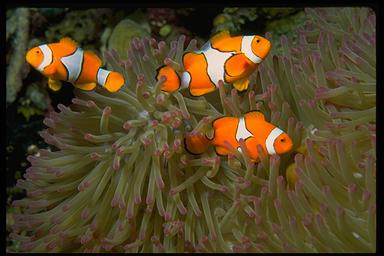
Clown Anemonefish
Clownfish belong to the genus Amphiprion and the family Pomacentridae, which includes the damselfishes.
Clownfish are often called anemonefish due to their symbiotic relationship with sea anemomes. In their natural habitat sea anemones provide good protection for anemonefish, and they are one of the few fishes that are able to reside among anemones without being stung by their tentacles. Because other fish can't get close to anemones, clownfish are safe from predators when they are among them.
Despite the ability of clownfish to exist among anemones without getting stung by their tentacles, it is possible to keep them in your aquarium without anemones. If you stock your aquarium appropriately, they are unlikely to encounter predators in captivity.
Clownfish are good fish for beginning salt water aquarists, but keeping sea anemones in your aquarium is more challenging. If you are a beginning saltwater aquarist you can definitely get an anemonefish, but you should wait until you are more experienced at marine fish keeping before you acquire a sea anemone. Because clownfish like to hide among anemones they may feel safer with one present, however. This is especially true if you have a wild-caught clownfish.
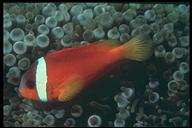
Tomato Clownfish
Because clownfish will breed in captivity, captive-born clownfish are readily available. It is always best to obtain captive-born fish whenever possible. They will be healthier and happier. It is very stressful for fish when they are taken from their natural environment and placed in captivity.
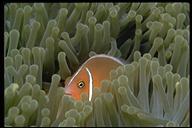
Skunk Clownfish
In their natural habitat clownfish are found on coral reefs and they make good fish for reef tanks. Also, it is worth mentioning that different species of clownfish have symbiotic relationships with specific species of anemones. For example, the clownfish anemonefish ( Amphiprion ocellaris) prefers a symbiotic relationship with the purple base anemone ( Heteractis magnifica), whereas the tomato clownfish (Amphiprion sebae) has a symbiotic relationship with the sebae (Heteractis crispa) and malu (Heteractis mulu) anemones. Before you get an anemone for your clownfish you should make sure that the species of fish is most compatible with the anemone species.
There are several species of clownfish to choose from and they are all beautiful fish that are easy (at least for saltwater fish) to keep in the aquarium. The photos on this page illustrate but a few of the available species of anemonefish available.
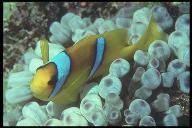
Orange Clownfish
They are small fish and reach an adult size of between 4-6 (10-15 cm) inches depending on the species. Also, note that some clownfish can be somewhat aggressive, especially toward members of their own species and genus. It is often best to keep them in pairs or singly.
They will eat a variety of marine aquarium fare, such as frozen and live foods. They should be given mysis shrimp, vitamin-enriched brine shrimp, zooplankton, and both meaty and plant-based frozen foods for marine fish.
Clownfish Spawning
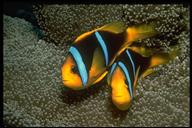
Two-bar Anemonefish
Anemonefish are unusual in that they are protandrous hermaphrodites. What this means is that they have the ability to change their sex. If you have a pair of juvenile clownfish of the same species in your aquarium, the largest of the two will become female. Then you'll have a male-female pair. Even if you purchase adult clownfish they still have the ability to change their sex as the need arises. The smaller one will always be the male.
In order for them to spawn, you should have the pair in a separate breeding tank. They will spawn in the absence of an anemone. You should provide them with some place to lay their eggs. Flat rocks or even a small piece of PVC pipe will do.
Although clownfish will breed in captivity, raising the fry may be somewhat difficult. Clown fish fry should be fed rotifers as soon as they hatch. Clownfish fry are very tiny and the only food they can eat are rotifers. In 4-5 days you should start adding crushed up or powdered dry food and newly hatched brine shrimp, but continue feeding the rotifers for about 2 weeks. For information on where to obtain rotifer cysts and hatching methods please see the article An Extensive Guide on Culturing Rotifers.
